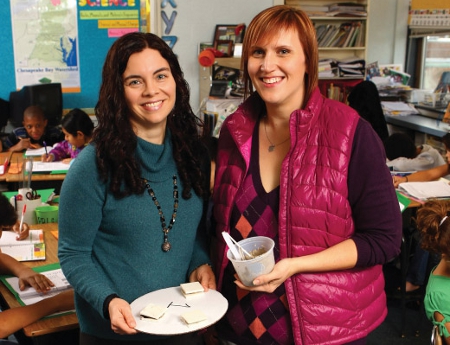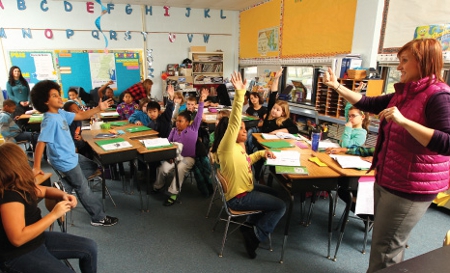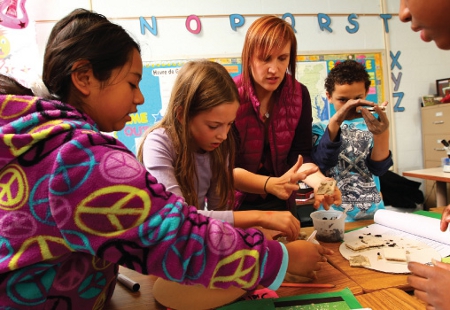Feature: A Deeper Partnership
Forget science fairs and drop-bys. Engineering educators now actively prepare teachers to deliver the ‘E’ in K-12 STEM. (From the January 2012 Prism magazine cover story by Mary Lord.)

Pamela Lottero-Perdue, left, integrated engineering into Havre de Grace (Md.) fourth grade teacher Alison Baranowski’s science class—then trained her to help students design, build, and test a wall made of tiles and “earth materials.”
It’s a flinty November morning and nearly every second-grade teacher in Harford County (Md.) Public Schools has bundled into a local school to witness a retooling of the district’s science classes. Students will spend six weeks learning about “Growth and Change” through agricultural engineering, starting with flowers and culminating in a hand-pollinator design project. Curriculum developer Pamela Lottero-Perdue, a Towson University science education professor and former engineer, directs the teachers to uncover a plate at each table and identify which foods are fruit. Apples, sure. But bell peppers and cukes?
Kids will say, “Eeew,” blurts a teacher. “The scientific definition is different from the nutritional one,” explains instructor Ashley Black, whose second graders piloted the engineering unit last year. Be prepared for complaining parents, she advises; most won’t know that fruit is a flower’s ripened ovary, whether apricot or zucchini, and will insist cucumbers are vegetables.
Behold the newest dimension of engineering education. Propelled by research and the country’s drive for more science, technology, engineering, and math (STEM) graduates, outreach programs have evolved well beyond the career-day talks, teacher workshops, and other one-shot efforts of a decade ago. “You can only do so many science fairs, and what impact does it have?” observes Beth McGrath, executive director of the Center for Innovation in Engineering and Science Education at New Jersey’s Stevens Institute of Technology.
Today’s engineering pipeline stretches from kindergarten design projects to video-game pilots to teacher prep programs, and often includes sustained relationships between universities and schools. As engineering faculty work with classroom teachers, regular science, math, or language arts instruction is being “engineer-ized,” says Elizabeth Parry, director of K-20 engineering partnerships at North Carolina State University and chair of the American Society for Engineering Education’s K-12 and Pre-College Division. A few pioneering institutions, like hers and Towson, are creating curriculum and delivering professional development to entire schools and districts.
Some indications that K-12 engineering is gaining momentum:
- Engineering is Elementary (EiE), a research-backed curriculum for primary school students developed by the Museum of Science, Boston, began with just eight teachers and 200 pupils seven years ago. Since then, it has reached 32,700 teachers and about 2.7 million students, often via university outreach efforts.
- Project Lead the Way, an engineering program launched in a dozen upstate New York schools in the mid-1990s, now includes 4,215 schools and more than 400,000 middle and high school students in every state.
- The number of research submissions on K-12 topics to ASEE’s annual conference has more than doubled in the past five years. In 2011, the K-12 & Pre-College Division received 220 abstracts and 158 papers, with 132 getting published.
Driving the trend
The growth of university involvement follows a 2005 exhortation from the National Academy of Engineering’s “The Engineer of 2020” that “the engineering establishment should participate in efforts… to improve math, science, and engineering education at the K-12 level.” The NSF now devotes 15 percent of its engineering education budget — which has averaged $30.7 million annually for the past decade — to K-12, a 2011 analysis calculated. Early NSF-sponsored projects centered on getting kids interested in STEM, particularly through such informal experiences as visiting a science museum. The emphasis has since switched to curricula, instruction, and classrooms.
Beyond improving science learning, engineering increasingly is seen as a vehicle to encourage critical thinking, problem solving, and creativity. “It’s a tool to provide passion,” says North Carolina State’s Parry, who works with the entire teaching staff in five schools on how to integrate engineering into every subject, including gym, and boost engagement across the board, not just in science.
Engineering in every HCPS elementary classroom.
Harford County Public Schools, where Towson Assistant Prof. Lottero-Perdue is customizing a curriculum to put the “E” in STEM for every elementary grade, offers one of the most vivid examples of these powerful new university-school partnerships. The SysTEMic project grew out of the Army’s desire to help communities near the Aberdeen Proving Ground east of Baltimore prepare schools for an influx of new families under its base-consolidation plan. The university and school district argued the merits of starting young with engineering, and in 2008 won a $100,000 grant. A big chunk went to train teachers.
“We can’t just say, ‘Oh, by the way, you’re going to be teaching engineering next year,’” says Lottero-Perdue, who modified and matched the Engineering is Elementary (EiE) curriculum to each grade’s state science content standards rather than tacking on a unit at the end. “They had no professional development in the subject. Some might not like science.” By showing that heating a drink or performing other everyday tasks can convey engineering concepts, Lottero-Perdue hoped to quell fears. “The whole point is to make teachers comfortable,” says Andrew Renzulli, HCPS’s science supervisor, who calls their enthusiasm for engineering “contagious.”
Since its 2009 launch, the SysTEMic project has received multiple grants, including from Maryland’s education department, and grown from a few pilots to all 33 elementary classrooms in the school system. “It’s a brand-new world,” beams Renzulli, who fired up the teachers at November’s training session by rhapsodizing about “the noise of learning” from excited kids doing engineering and science. That time is reserved during the district’s quarterly professional development days for Lottero-Perdue and her seasoned teachers to coach engineering underscores HCPS’s commitment to the effort. “We didn’t want it to be a one-stop wonder,” says Lottero-Perdue, who holds a bachelor’s degree in mechanical engineering and spent a year in industry before migrating to education, first as a master high school engineering and physics teacher, then earning a doctorate in science curriculum and instruction. She calculates that when Harford County pupils board the buses in June, all will have learned one engineering unit in grades 1 through 4 and two in grade 5 — taught largely by teachers she trained.
“This was difficult!”
Alison Baranowski, a fourth-grade teacher at Havre de Grace Elementary School and an early recipient of Lottero-Perdue’s professional development, has seen her mostly low-income students’ engagement in science soar with the inclusion of engineering. “During lessons, students ask questions, think outside the box, and more than anything start to think like problem solvers,” Baranowski reports. “Every ability level can participate, too.”
Integrating engineering also has influenced how Baranowski teaches science. “I try to ask questions instead of dishing out content,” she explains, adding that she also likes to familiarize students with the scientific method and turn more activities into experiments.

Fourth grade engineers show what the “noise of learning” looks like in Alison Baranowski’s science class. “Every ability level can participate,” she says.
In previous years, Baranowski’s fourth graders would have learned about geology and erosion in the “rocks and minerals” curriculum. With the new materials-engineering unit, students apply content knowledge to construct a tile wall that can withstand a “wrecking ball.” The design process starts with reading a book about a Chinese girl who engineered a solution to a problem. The fourth graders then do the same, investigating the properties of sand, soil, and other earth materials to determine which would best keep tiles together. Finally, teams test their walls against a golf ball pendulum. “Exciting times!” Baranowski exclaims. “Thinking like engineers and using the engineer-design process has been incredible.”

Guiding designers through a test of “mortar” materials, Baranowski has learned to ask questions rather than “dish out content.”
Embedding engineering into STEM instruction required a similar all-hands effort. The district’s elementary science specialist, Amy Ryan, found EiE units to match existing curriculum. After brainstorming on how to merge them, Lottero-Perdue drafted a blended unit. “I often had to reduce science in order to make time for the engineering,” recalls Lottero-Perdue. “This was difficult!” She modified existing science lessons, developed new ones, and wrote guides to translate science concepts into engineering concepts and processes. Kids, she finds, “particularly love the idea that they can work to solve a problem via the engineering design process for which the teacher doesn’t hold the one single answer!”
Filed under: Special Features
Tags: Class Activities, Elementary Education, Higher Education, K-12 engineering, Teacher Training








